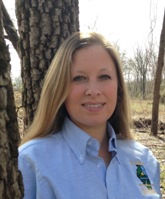- Click the Events link above or
- Check out the Beall Woods events brochure
Tuliptree Trail (1 mile) - The awe-inspiring size of the deciduous trees can be realized while walking under the canopy of this easy upland trail. Visitors are encouraged to bring along binoculars for leaf identification and birding. Along with two bridge crossings, hikers will have a bird’s eye view of Coffee Creek.
White Oak Trail (1.75 mile) - With the exception of two flights of stairs, the White Oak is a moderately easy trail offering hikers the greatest variety of vegetation and forest conditions. It passes over five soil types, through upland and bottomland forest, and gives visitors a sense of what settlers experienced when arriving at this part of the state. The Wabash River can be viewed from this trail.
Ridgway Trail (1.75 mile) - For those interested in a longer hike, this moderately-easy trail may be accessed from the White Oak trail at the low water crossing. It is a dedicated living memorial to Robert Ridgway, one of America's foremost ornithologists, who spent his boyhood in this area. Closed periodically during flooding, this trail winds through a reforested field and features several species of bottomland oak and hickory trees. A combined White Oak-Ridgway Trail walk is 3 miles in length.
Sweet Gum Trail (0.5 mile) – This short, picturesque trail meandering along Coffee Creek features an interesting rock cliff. Many plants adapted to cool, moist, and shady conditions are found in this area. The visitor must access this trail from the park's north side. The trail is closed periodically due to flooding.
Schneck Trail (1.75 mile) - Dedicated to Dr. Jacob Schneck, a pioneer Mount Carmel physician and botanist, this typical bottomland area consists of several bottomland oak and hickory species. The trail must be accessed from the north side of the park and is closed periodically due to flooding.
History of Beall Woods
Located on the banks of the Wabash River in southeastern Illinois, Beall Woods State Park attracts visitors from around the world wanting a glimpse of one of the few remaining tracts of old-growth forest found east of the Mississippi River.
The property now known as Beall Woods State Park (pronounced Bell) was under the ownership of the Beall family since the mid-1800s. While a working farm, almost half of the 635 acres consisted of forest that had been left relatively untouched by man. When Laura Beall, the last living heir, died without a will, the property went up for auction and was sold to a man who intended to cut the timber. Several individuals and organizations came together to prevent this from happening, a trial ensued and the land was purchased by the state of Illinois in 1965 by invoking the law of eminent domain against the unwilling seller. In 1966, 329 acres of old-growth forest was dedicated as the 14th Illinois Nature Preserve by the Illinois Nature Preserves Commission. With this action, a piece of Illinois’ natural heritage was preserved so that future generations will have the opportunity to see an example of the magnificent forest that once grew along the Wabash River.
The Visitor Center, built in 2001, houses displays about the history of the property and the native flora and fauna found in the area. School groups, scouts, church groups, clubs, and other visitors utilize this facility and participate in educational programs throughout the year.
A wildlife viewing area is located behind the Visitor Center. Observers will most frequently see chickadees, nuthatches, woodpeckers, finches, cardinals, and hummingbirds at the feeding station, as well as the “very healthy” squirrels. Bullfrogs are often seen sunning themselves near the pond while keeping a watchful eye for the resident black rat snake. On rarer occasions, white-tailed deer, opossums, raccoons, and skunks visit the area.
Hiking at Beall Woods
Sometimes acclaimed the “University of Trees,” Beall Woods is more than a collection of super-sized deciduous trees. It is a living forest community – a natural ecological system containing a variety of native plant and animal life.
Quiet hikers may notice the undulating flight of the pileated woodpecker, leaves rustling from Fowler’s toads hopping about, the quick flash of skinks running in and out of decaying logs, and deer staring back intensely as they try to remain unseen.
During spring, wildflowers carpet the forest floor. Blooms of white, yellow, purple, and pink are showcased along the trails. Feel free to bring along your camera to capture the intricate design and delicate nature of these spring beauties.
Events
Trail Information
Five established trails offer hikers excellent views of Beall Woods' old-growth forest. From the easy 1-mile Tuliptree Trail to the 1.75-mile moderately easy White Oak Trail, the nature enthusiast can get a sense of what the settlers saw when they arrived at the banks of the Wabash River.
To preserve the fragile ecosystem, hikers are urged to stay on established trails. Pets, bicycles and horses are not allowed on trails. Collecting or removing any natural object is prohibited. Depending on the season, visitors should come prepared with insect repellent. Since low areas are subject to flooding and standing water, trail conditions are posted by the front door of the Visitor Center.
Natural Resources Coordinator: Jacque Cullison
Contact Information:
Beall Woods State Park
9825 Beall Woods Avenue
Mt. Carmel, IL 62863
618-298-2441







